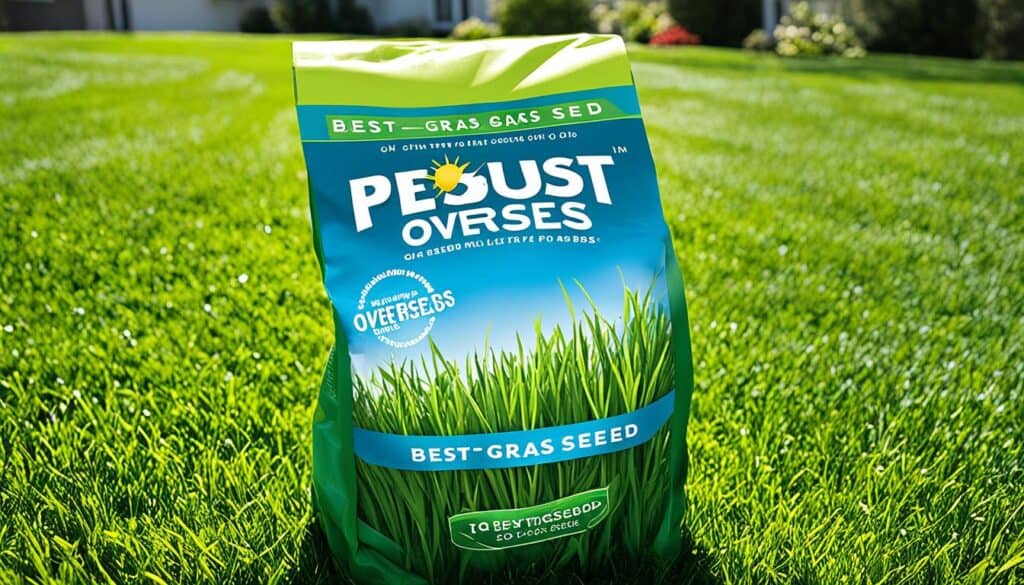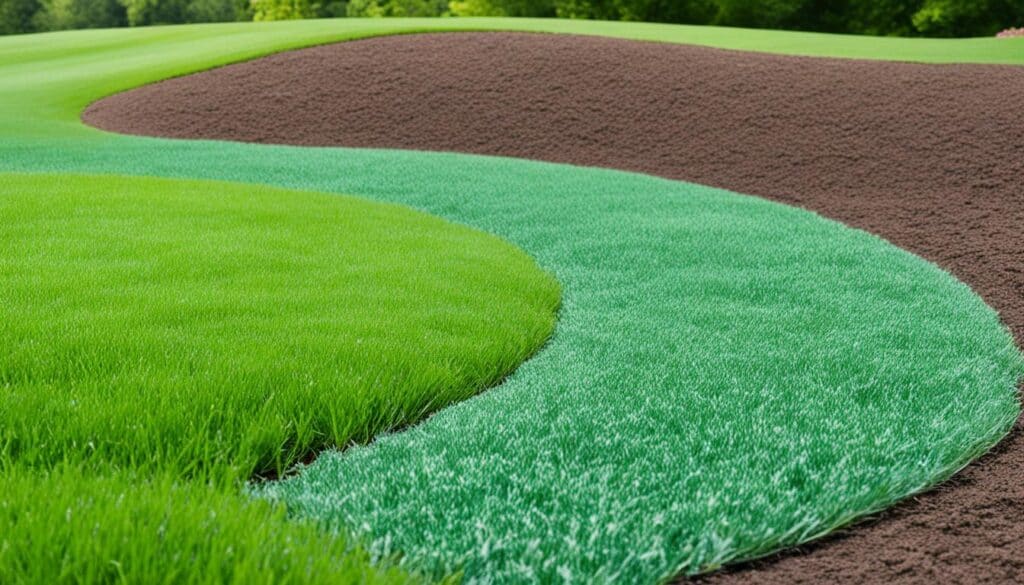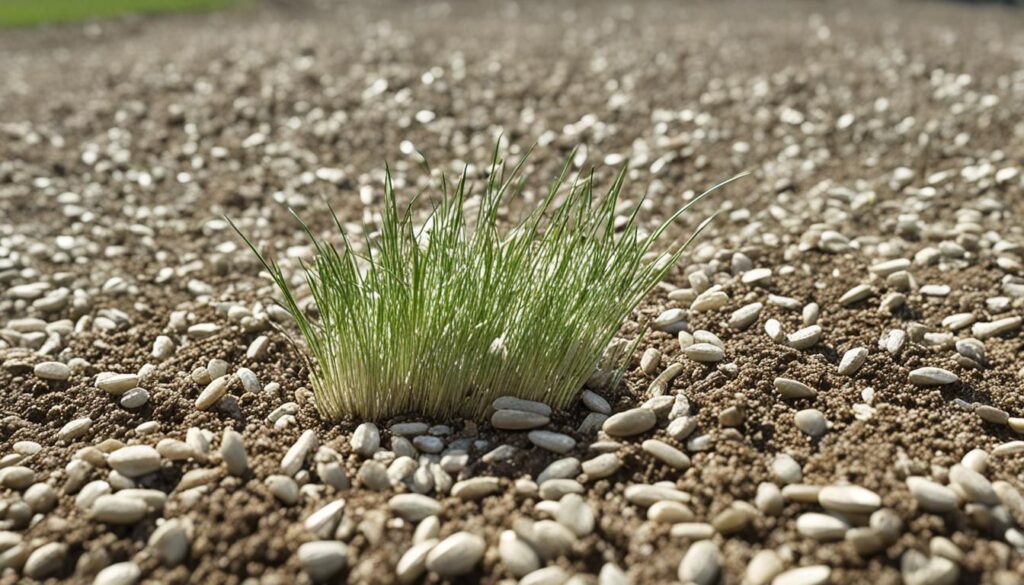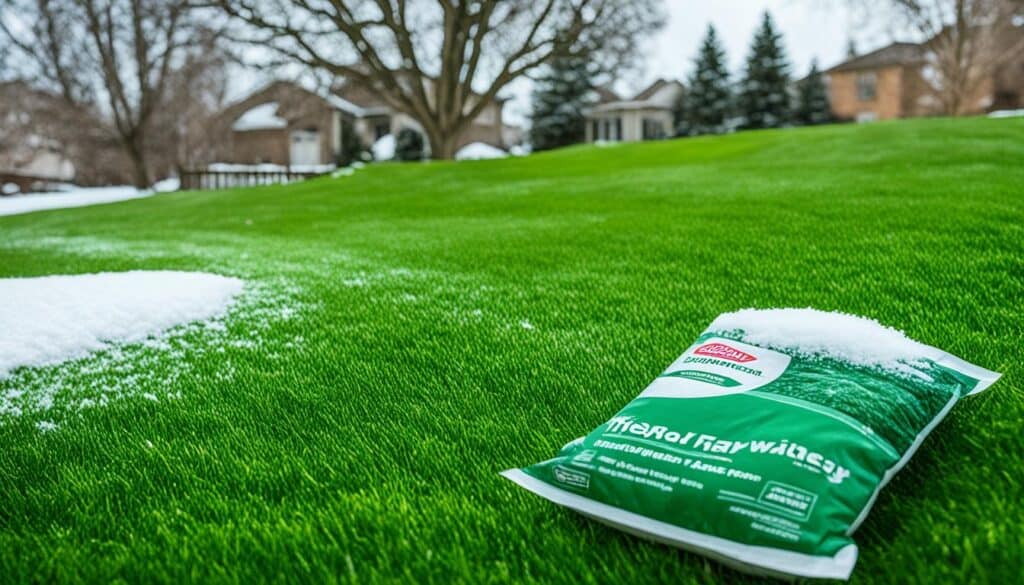Did you know Ohio has 12 different soil types? This variety makes lawn care a challenge for those in the Buckeye State. Choosing the right grass seed for overseeding lawn Ohio is key to a lush, green lawn. The state’s varied climate and soil need the right grass type.
Ohio fits perfectly into USDA hardiness zones 5b, 6a, and 6b, making it great for cool-season grasses. Kentucky bluegrass, perennial ryegrass, tall fescue, and fine fescue are top choices for overseeding. Each type has its own benefits for different lawns and conditions.
When picking the best grass seed for Ohio, think about sun, soil, and how you’ll use your lawn. Kentucky bluegrass loves full sun and moist, well-drained soil. Fine fescue does well in shade with less moisture. Knowing these details helps you choose the right seed for your lawn.
Key Takeaways
- Ohio has 12 distinct soil regions, influencing grass growth patterns
- Cool-season grasses are best suited for Ohio’s climate
- Kentucky bluegrass is the primary turfgrass in Ohio
- Perennial ryegrass offers rapid germination for quick establishment
- Tall fescue provides excellent drought tolerance
- Fine fescue thrives in shaded areas with low moisture
- Selecting the right grass seed blend is crucial for successful overseeding
Understanding Ohio’s Climate and Soil Conditions
Ohio’s climate and soil are key to the success of overseeding cool season grass. The state ranges from USDA hardiness zones 5b to 6b. This means soil temperatures are between -15 to 0 degrees Fahrenheit. Such conditions are perfect for cool-season grasses.
Ohio grass seed blends like Kentucky bluegrass, perennial ryegrass, and fescues are popular choices.
Ohio’s Unique Growing Challenges
Ohio’s climate poses challenges for grass growth. Cold winters and hot summers stress lawns. To plant grass seeds, wait until soil temperatures are at least 60 degrees Fahrenheit.
Weather patterns can delay planting. So, timing is key for overseeding in Ohio.
Soil Types Across the Buckeye State
Ohio has 12 soil regions, with Miamian soil covering 750,000 acres. Mining and farming have affected soil health. It’s wise to test soil every three years to check pH levels and nutrients.
This info helps in choosing the right ohio grass seed blends.
Impact of Weather Patterns on Grass Growth
Temperature and rainfall greatly affect grass growth and overseeding. Ohio’s climate is good for cool-season grasses. For wet spots, Kentucky bluegrass and fescue are best.
For dry areas, tall fescue is a good choice. It’s also good for lawns that often face dry spells.
| Soil Type | Recommended Grass | Best Planting Time |
|---|---|---|
| Clay | Tall Fescue, Kentucky Bluegrass | Early Fall |
| Sandy | Tall Fescue, Zoysia | Late Spring |
| Acidic | Fine Fescue, Perennial Ryegrass | Early Fall |
| Alkaline | Perennial Ryegrass, Meadow Bromegrass | Late Summer |
Ideal Timing for Overseeding in Ohio
Timing is key for overseeding your lawn in Ohio. The best time is usually from early September to late October. This is when the grass seed germinates and grows best.
Cool-season grasses do well in temperatures between 60 to 75 degrees Fahrenheit. Overseeding in the fall uses warm soil for seed germination and cooler air for growth.

For the best results, overseed after core aeration. This helps seeds make good contact with the soil, leading to better germination. Don’t overseed in spring, as new grass may struggle with the heat and herbicides.
| Region | Optimal Overseeding Window | Recommended Grass Types |
|---|---|---|
| Northern Ohio | August 15 – September 15 | Kentucky Bluegrass, Perennial Ryegrass |
| Central Ohio | September 1 – October 15 | Tall Fescue, Fine Fescue |
| Southern Ohio | September 15 – October 31 | Tall Fescue, Perennial Ryegrass |
Adjust your soil pH to 6.2-7.0 for better grass growth. Use products like MAG-I-CAL® for this. After overseeding, a high-phosphorus fertilizer will help your lawn’s roots grow strong.
Best Grass Seed for Overseeding in Ohio
Choosing the right grass seed for overseeding in Ohio is key for a lush, healthy lawn. Ohio’s climate and soil vary, so different grass types offer unique benefits.
Kentucky Bluegrass: The Ohio Favorite
Kentucky Bluegrass is a top choice for Ohio lawns. It grows thick and recovers quickly from damage. Perfect for sunny spots and busy areas.
Perennial Ryegrass: Quick Establishment
For fast results, overseed with ryegrass in Ohio. It germinates quickly, ideal for filling bare spots or fixing summer damage. It mixes well with other grasses for a strong lawn.
Tall Fescue: Drought-Resistant Option
Choose tall fescue for Ohio lawns that need to withstand drought. These varieties resist wear and grow on different soils. Their deep roots make them more resilient.
Fine Fescue: Shade-Tolerant Choice
Fine Fescue shines in shady spots and poor soil. It’s easy to care for and blends well with other grasses. This makes your lawn diverse and adaptable.
| Grass Type | Best Features | Ideal Conditions |
|---|---|---|
| Kentucky Bluegrass | Dense, fine texture | Sunny areas, high traffic |
| Perennial Ryegrass | Quick germination | Bare spots, summer damage repair |
| Tall Fescue | Drought resistant, deep roots | Various soil types, low water areas |
| Fine Fescue | Shade tolerant, low maintenance | Shaded areas, low fertility soils |
For the best results, mix different grass types. This mix helps your lawn thrive in Ohio’s varied conditions. It makes your yard look great all year.
Characteristics of Quality Overseeding Grass Seed
Choosing the right grass seed for overseeding in Ohio is key. Quality seeds lead to a lush, strong lawn that does well in Ohio’s climate.
Germination Rate and Purity
Great Ohio grass seed has high germination rates and purity. Aim for seeds with germination rates over 85% and purity above 95%. These traits greatly help your lawn succeed.
Disease Resistance
Ohio’s weather is perfect for lawn diseases. Choosing seeds with strong disease resistance is crucial for a healthy lawn. Kentucky Bluegrass and Perennial Ryegrass are great for this.
Drought Tolerance
Ohio’s weather can be dry. Tall Fescue and Fine Fescue are excellent for dry conditions. They’re top picks for overseeding in Ohio.

| Grass Type | Texture Quality | Maintenance | Seedling Rate (lbs/1000 sq ft) |
|---|---|---|---|
| Kentucky Bluegrass | Excellent | Moderate to High | 2 – 3 |
| Perennial Ryegrass | Good | Moderate to High | 7 – 10 |
| Tall Fescue | Very Good | Low to Moderate | 8 – 10 |
| Fine Fescue | Good | Low to Moderate | 5 |
Think about these traits when picking your grass seed. The best seed for Ohio depends on your lawn and how you maintain it.
Top Grass Seed Blends for Ohio Lawns
Choosing the right grass seed blend is key when overseeding in Ohio. Ohio’s diverse climate calls for specific grass types combined into blends. These blends create resilient, attractive lawns.
Jonathan Green’s Black Beauty® grass seeds are a top pick for Ohio lawns. They are deeply rooted, fight off diseases, and can handle drought. These seeds germinate in about 14 days and can make any lawn look better.
A good grass seed blend for Ohio lawns includes:
- 80% turf-type tall fescue
- 10% Kentucky bluegrass
- 10% perennial ryegrass
This mix is great for quick growth and lasting strength. Turf-type tall fescue starts in 10-14 days. Kentucky bluegrass takes a bit longer, at 10-21 days. Perennial ryegrass sprouts fast, in just 3-5 days.
| Grass Type | Germination Time | Benefits |
|---|---|---|
| Turf-type Tall Fescue | 10-14 days | Drought-resistant, deep roots |
| Kentucky Bluegrass | 10-21 days | Dense growth, self-repairing |
| Perennial Ryegrass | 3-5 days | Quick establishment, wear-resistant |
For successful overseeding in Ohio, make sure the seeds touch the soil well. Remove dead grass and loosen the soil an inch deep before seeding. Water your new lawn about 1.5 inches a week to help it grow strong.
Proper Overseeding Techniques for Ohio Lawns
Overseeding your lawn in Ohio can make it look lush and green. The best time to overseed is early fall. This lets new grass grow strong before winter. Here are the steps to make your overseeding project a success.
Soil Preparation
First, test your soil’s pH level. It should be between 6.2 and 7.0 for lawns. Use organic lime to fix acidic soil or a soil acidifier for basic soil.
Aerate your lawn to help seeds grow better. This is a key step for overseeding in Ohio.
Seeding Methods
Spread 1-2 lbs of grass seed per 1,000 square feet. Use a spreader for even coverage. Then, rake the seeds into the soil gently.
For big areas, think about using a slit seeder or a de-thatching machine.
Watering and Fertilization
Water the new seeds 1-2 times a day until they germinate. Then, water once a week, giving 1 inch of water. Use a fertilizer high in phosphorus to help roots grow strong.
Don’t forget, not watering enough is the main reason for poor seeding results.
| Task | Frequency | Duration |
|---|---|---|
| Watering (pre-germination) | 1-2 times daily | Until germination (10-14 days) |
| Watering (post-germination) | Weekly | 1″ per week |
| Fertilization | Once at seeding | As per product instructions |
Follow these steps for a successful overseeding project. You’ll end up with a thicker, healthier lawn. Just wait to treat new weeds until your grass has been mowed at least 4 times.
Conclusion
Choosing the right grass seed for overseeding in Ohio is crucial for a lush, healthy lawn. Ohio’s varied climate and soil types mean you need to pick grasses that do well in your area. Kentucky Bluegrass, Perennial Ryegrass, and Fescues are top picks for overseeding in Ohio, each with its own benefits.
Timing is key when you’re overseeding. In Ohio, mid to late August is a great time for fall seeding. This lets the grass get established before winter hits. Also, if you’ve used herbicides like Roundup for Lawns 3, wait at least 4 weeks before you seed again for the best outcomes.
Using a mix of grass seeds can make your lawn more resistant to diseases and drought. When picking your seeds, choose ones with high germination rates (over 75%). Calculate how much you need based on your lawn’s size. You’ll usually need between 2 to 12 pounds of seed per 1,000 square feet, depending on your lawn’s current state.
By understanding Ohio’s unique growing challenges and using the right overseeding methods, you can improve your lawn. Whether you’re fighting with clay soil, shade, or heavy foot traffic, there’s a grass seed for overseeding in Ohio that can help you get the lawn you want.




Thanks for sharing. I read many of your blog posts, cool, your blog is very good.